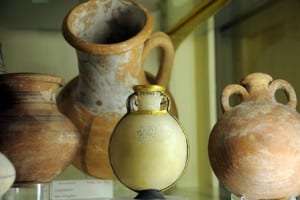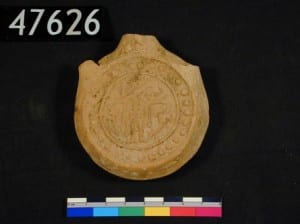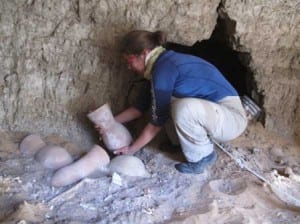Pottery Project Guest Blog: Biography of an Egyptian Pilgrim Flask
By Alice Stevenson, on 28 February 2014
Guest Blog by Loretta Kilroe
In the first of our series of different perspectives on Egyptian pottery, graduate student Loretta Kilroe looks at pots she is hoping to devote 3 years of doctoral study to.
I’m currently researching pilgrim flasks – vessels with a lentoid body, narrow neck, and two handles for suspension. These striking pots first appear in New Kingdom Egypt (c.1550–1069BC). They were originally traded from the Levant, but soon enthusiastically adopted into the traditional repertoire and made by Egyptian potters themselves. One beautifully-preserved flask in the Petrie Museum particularly caught my eye, UC66492.
The fabric provides some basic information. It is made of Nile Clay, with occasional large white inclusions. This means the vessel was formed by a potter in Egypt, rather than imported from the Levant. The potter formed the body of the vessel by making two bowls on a potter’s wheel and fixing them together, a Near Eastern technique, and then covered it all in a fine red slip. Since there are no breaks in this slip, it is difficult to judge exactly which sub-division of Nile Clay this was made from, which might have allowed us to pinpoint a closer origin. However, the regularity of its form and the purity of the fabric do indicate this was a well-made item, and probably relatively expensive.
The fabric also allows us to date the vessel to the late New Kingdom; earlier Egyptian flasks tended to be made out of the hard white clay known as marl. It was only in Dynasty 19 that Nile Clay pilgrim flasks grew in popularity, perhaps indicating that the form had become popular among wider segments of society.
The decoration of concentric circles on the body of the flask is a very common feature, and is probably copied from the original Levantine imports. Why did this decorative style persist for so long? It is possible that it had become synonymous with a particular material. Archaeologists are still uncertain as to what Levantine pilgrim flasks were imported for; undoubtedly, they contained something precious, and something only used in small quantities judging by their average size. There are two theories floating around at the moment. Popularly, flasks have been thought to contain precious oil, in all likelihood used for perfume. As yet, the evidence pointing towards this is circumstantial, but convincing – their common appearance within graves, indicating they contained something personal, and the way they were so enthusiastically and wholeheartedly adopted into the Egyptian ceramic repertoire, to the extent they are still made in the Christian period – the Egyptians were very fond of perfumes! However, Janine Bourriau has suggested that the vessels contained a spice or liquor for adding to wine. This intriguing idea is based on the fact that flasks and wine amphorae are often found together in Levantine contexts.
More research will be needed to discover what exactly was behind the craze, but what is clear is that this decoration of concentric circles continued to be added even when vessels were no longer imported. This strongly suggests the decoration was a form of branding, working just like a stamped symbol on a perfume bottle today. This vessel then, probably contained something easily recognisable and in demand.
This pilgrim flask probably ended its life as a grave good. While the fact the flask is complete is obviously not unusual in a museum display, it is an uncommon (and very exciting) thing to find while excavating. Complete vessels are almost always from graves, where they were protected from rebuilding phases and trampling feet.
However, this doesn’t mean that the vessel was buried with original contents intact, or even just after it was emptied. It is very common for pots, once their original function is obsolete, to be ‘transformed’ in use, to contain other substances. The vessel had taken some time to make, so they wouldn’t want to waste it! Inside the neck of the vessel I found remains of vegetation, probably the remains of a stopper. While documenting pottery at Amara West, Sudan, I encountered mud stoppers still sealing bottles, although these dissolved into nothing at their first encounter with Sudanese winds for a few thousand years. So it is quite common for stoppers to be preserved. This suggests that the flask was filled with something for burial – or, was supposed to give that impression…another symbol?
This vessel however, to me, raises as many questions as it answers. Why were pilgrim flasks absorbed into Egyptian culture when stirrup jars, part of the same Levantine repertoire and also imported, were not? What did this vessel mean to the person (or persons) who decided to include it in a grave? And why is there so much variance in body and handle shape across flasks?
This pot provides us with a glimpse into daily life in Egyptian society; but it also goes a long way to challenging the idea that ceramic vessels were always cheap and throwaway. It shows that pottery can also be used to trace social shifts, interests and etiquette – certainly not a dull find!
7 Responses to “Pottery Project Guest Blog: Biography of an Egyptian Pilgrim Flask”
- 1
-
2
Margaret Maitland wrote on 1 March 2014:
Nice article. I recently read that some of these flasks found in Israel had traces of cinnamon in them: http://archaeology.org/news/1237-130822-israel-cinnamon-spice-trade Hopefully more examples can be analysed in the future!
-
3
anlen boshoff wrote on 7 March 2014:
There is a pilgrim’s flask on display in the Slave Lodge Museum in Cape Town, SA. It was found at Amarna. No decoration.
-
4
Marcus wrote on 18 March 2014:
Absolutely fascinating, thank you for sharing this, Loretta. I’ve always been interested in ancient Egyptian culture and archaeology; you’ve awaken by inner Indian Jones!
- 5
-
6
facebook_dbickerstaffe1 wrote on 4 April 2015:

Very interesting. Are there parallels in the development of Levantine amphorae? Both as imports and the creation of local imitation styles?
-
7
Loretta Kilroe wrote on 13 April 2015:
Yes some very interesting work has been carried out on Levantine amphorae; I am thinking in particular of a typology entitled ‘Levantine Storage jars of the 13th to 4th century BC’ by Sagona from 1982 which traces morphological changes in their shapes across time. We do in addition see both pilgrim flasks and amphorae imitated contemporaneously in the early New Kingdom in Marl D, seemingly a royal controlled fabric, so there seems to be a connection between them at this period. Margaret Serpico has set up a project to research Canaanite amphorae, looking at their possible contents and the exact origins of various fabric types, which is definitely worth looking at if you are interested: http://www.amarnaproject.com/pages/recent_projects/material_culture/canaanite.shtml
 Close
Close






it,s nice to read something special about Egyptian Flasks so thanks about that